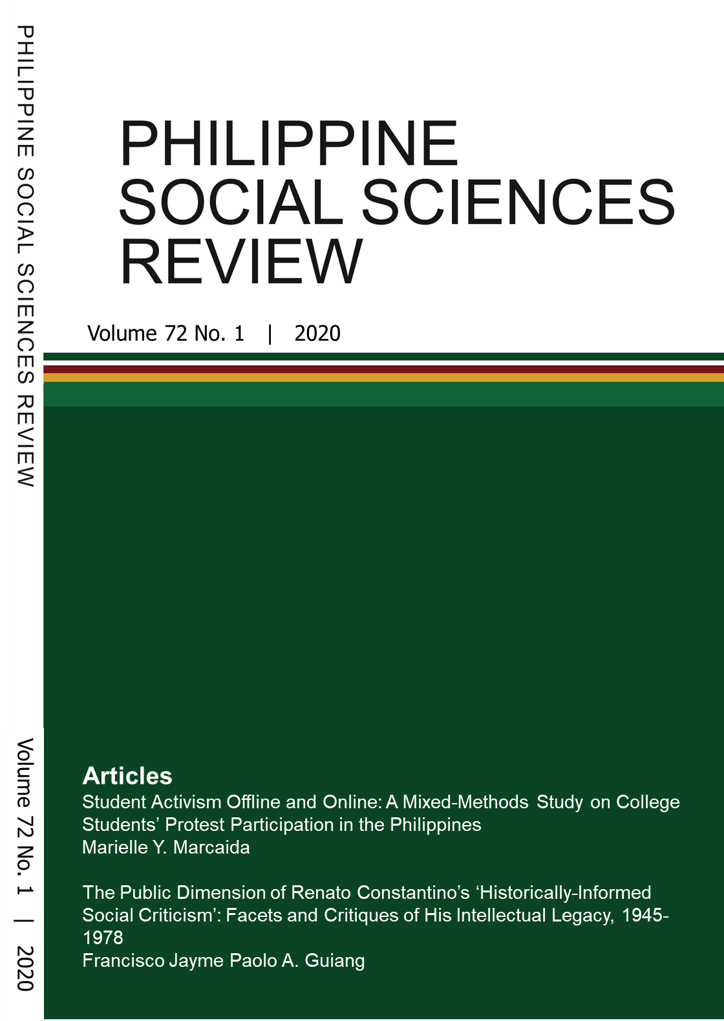Editor's Note
Abstract
This issue of the Philippine Social Sciences Review (PSSR) comes with two articles that speak to the notion and practice of activism. The first is by Francisco Jayme Paolo A. Guiang on The Public Dimension of Renato Constantino’s ‘Historically-Informed Social Criticism’: Facets and Critiques of His Intellectual Legacy, 1945-1978 while the second is by Marielle Y. Marcaida on Student Activism Offline and Online: A Mixed-Methods Study on College Students’ Protest Participation in the Philippines.Guiang examines the activist scholarship of Renato Constantino specific to his (Constantino’s) practice of social criticism informed by history – specifying the burning issues of society “interwoven with historical analyses” (p. 3) [this will change in the final layout] – a departure from the more traditional (“ivory tower”) historical writing that aspires detachment and neutrality. In contrast to academic historical writing, Constantino’s journalistic style encourages historical reflexivity and praxis among his readers. His nationalist and anti-imperialist agenda are evident in all his writings as he exerts much effort to cultivate a mass counter-consciousness. However, Guiang rightly observes that while Constantino makes much use of social criticism, he did not seem to discuss the concept itself at all in his works.
Guiang offers a balanced assessment of Constantino as social critic and historian. He cites scholars like John N. Schumacher, Glenn Anthony May, and Vicente L. Rafael who are critical of Constantino’s extensive use of a Marxist lens and social criticism at the expense of historical accuracy. Guiang also takes note of the recognition that Constantino receives from James Petras and Rosalinda P. Ofreneo for his anti-colonial viewpoints that few academics would dare express openly.
Constantino’s essays are meant to trigger debate and motivate the reader to act. It is common practice nowadays to issue “trigger warnings” for disturbing content. Perhaps Constantino’s works should also come with a similar trigger warning because they offer content that many would find disturbing enough to act against an unjust order that has been perpetuated by a society and a political system profoundly subservient to neocolonial goals.
In the end, the article leads one to wonders whether Constantino is celebrated for his scholarship because of his nationalist sentiments or despite them. Regardless of how scholars feel about his work, Constantino was more a propagandist than a dispassionate scholar and he would have been proud to be labeled as such.
A bit of activist scholarship is the one by Marcaida whose article looks at the relationship between student political activism and social media. Her work speaks to the power and influence of social media. Moreover, there is no better time for Marcaida’s work to come out than in the midst of the COVID-19 pandemic when people all over the world are on lockdown and forced to rely on the Internet and social media for contact with the outside world.
She examines how social media feeds into student activism at two levels – digital (online protest actions) and traditional (physical participation in protest actions). Her data reveal that students who access social media for news “have higher chances of engaging in online protest activities than offline protest actions” (pp. 16-17 [this page will change in the final layout]). This may be for reasons of convenience. However, an interesting facet of Marcaida’s research is the nuance in her findings that students who engage in digital activism do not consider themselves as engaging in real activism having associated student activism with the more traditional (tactile?) variety. Marcaida did her fieldwork for this study prior to the COVID-19 pandemic. It would be interesting to see how this kind of nuancing plays out today. Nevertheless, political activism among the youth, in whatever form it takes, is a sign of a healthy democracy.


